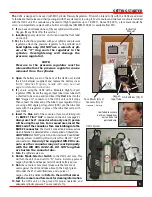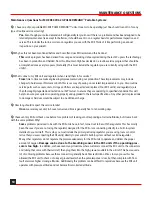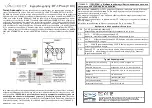
13
13
WHAT EVERY PILOT SHOULD KNOW ABOUT OXYGEN
What Is Air?
The air surrounding us is a mixture of gases consisting of 78% nitrogen and 21% oxygen. The remaining 1% is made up of argon, carbon
dioxide, and traces of rare gases.
What Is Oxygen?
Under normal conditions, pure oxygen is a colorless, tasteless, odorless, non-combustible gas. It is the most important single element in our
universe.
Why Is Oxygen So Important?
Although it will not burn alone, oxygen supports combustion; in fact, without oxygen there can be no fire. Oxygen, therefore, is not only
necessary for the burning of combustible materials, but it is also absolutely essential to support the process of “vital combustion” which
maintains human life. Although a person can live for weeks without food or for days without water, he or she dies in minutes if deprived of
oxygen. The human body is essentially a converter which consumes fuel and produces heat and energy. It is like a furnace which utilizes the
oxygen in the air to burn coal, thus producing heat and power. The human body must have oxygen to convert fuel (the carbohydrates, fats,
and proteins in our diet) into heat, energy, and life. The conversion of body fuels into life is similar to the process of combustion; fuel and
oxygen are consumed, while heat and energy are generated. This process is known as “metabolism.”
Where And How Do We Normally Obtain Our Oxygen?
At each breath we fill our lungs with air containing 21% oxygen. Millions of tiny air sacs (known as “alveoli”) in our lungs inflate like tiny
balloons. In the minutely thin walls enclosing each sac are microscopic capillaries, through which blood is constantly transporting oxygen
from the lungs to every cell in the body. Because the body has no way to store oxygen, it leads a breath-to-breath existence.
How Much Oxygen Does The Human Body Need?
The rate of metabolism, which determines the need for and consumption of oxygen, depends on the degree of physical activity or mental
stress of the individual. A person walking at a brisk pace will consume about four times as much oxygen as he or she would when sitting
quietly. Under severe exertion or stress, he or she could be consuming eight times as much oxygen as when resting.
What Happens If The Body Does Not Receive Enough Oxygen?
When the body is deprived of an adequate oxygen supply, even for a short period, various organs and processes in the body begin to suffer
impairment from oxygen deficiency. This condition is known as “hypoxia.” Hypoxia affects every cell in the body, but especially the brain and
the body’s nervous system. This makes hypoxia extremely insidious, difficult to recognize, and a serious hazard especially for flight personnel.
What Are The Effects Of Hypoxia?
Hypoxia causes impairment of vision (especially at night), lassitude, drowsiness, fatigue, headache, euphoria (a false sense of exhilaration),
and temporary psychological disturbance. These effects do not necessarily occur in the same sequence nor to the same extent in all individu-
als, but are typical in average persons who are affeded by hypoxia.
When And Why Must We Use Extra Oxygen?
Supplementary oxygen must be used to enrich the air we breathe to compensate for either a deficiency on the part of the individual or a de-
ficiency in the atmosphere in which we are breathing. A person may have a respiratory or circulatory impairment which reduces the ability of
the body to utilize the 21% oxygen in the air. For such a person, supplementary oxygen must be administered by an oxygen tent or by oxygen
mask to enrich the inhaled air. The total volume of oxygen in each inhalation is then so much greater than normal that it compensates for the
individual’s own physical inability to utilize normal atmospheric oxygen. When we ascend in altitude, a different condition is encountered: a
condition in which the individual may be perfectly normal, but in which there is an oxygen deficiency in the atmosphere and supplementary
oxygen must therefore be used.
Does The Percentage Of Oxygen In The Air Change With Altitude?
No, the ratio of oxygen to nitrogen in the composition of air does not change. The 21% of oxygen in the air remains relatively constant at
altitudes up to one hundred thousand feet.
Why Must We Use Extra Oxygen When We Ascend In Altitude?
The blanket of air which surrounds our planet is several hundred miles thick, compressible, and has weight. The air closest to the earth is
supporting the weight of the air above it and, therefore, is more dense; its molecules are packed closer together. As we ascend in altitude, the
air is less dense. For example, at 10,000 feet, the atmospheric pressure is only two-thirds of that at ground level. Consequently, the air is less
dense, and each lungful of air contains only two thirds as many molecules of oxygen as it did at ground level. At 18,000 feet the atmospheric
pressure is only one-half of that at ground level. Although the percentage of oxygen is still the same as at ground level, the number of mol-
ecules of oxygen in each lungful is reduced by one-half. As we ascend, there is a progressive reduction in the amount of oxygen taken into
the lungs with each breath, and a corresponding decrease in the amount of oxygen available for the bloodstream to pick up and transport
to every cell in the body. To compensate for this progressive oxygen deficiency, we must add pure oxygen to the air we breathe in order to
maintain enough oxygen molecules to supply the metabolic needs of the body.
At What Altitudes Should Oxygen Be Used?
In general, it can be assumed that the normal, healthy individual is unlikely to need supplementary oxygen at altitudes below 8,000 feet. One
exception is night flying. Because the retina of the eye is affected by even extremely mild hypoxia, deterioration of night vision becomes sig-
nificant above 5,000 feet. Between 8,000 and 12,000 feet, hypoxia may cause the first signs of fatigue, drowsiness, sluggishness, headache,
and slower reaction time. At 15,000 feet, the hypoxic effect becomes increasingly apparent in terms of impaired efficiency, increased
drowsiness, errors in judgment, and difficulty with simple tasks requiring mental alertness or muscular coordination. These symptoms become
more intensified with progressively higher ascent or with prolonged exposure. At 20,000 feet, a pilot may scarcely be able to see, much less
read, the instruments. His or her hearing, perception, judgment, comprehension, and general mental and physical faculties are practically use
(continued on next page)


































